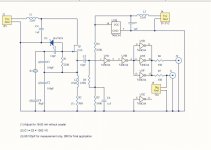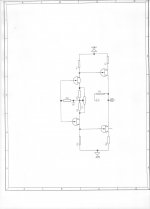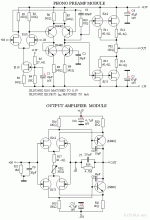You've never worked in a busy service dept thenG8's, G9's G11's (redefining the term dry joint), KT3's KT4's Theatre Panel Pye's, the Charlie decks, the Turbo decks, the Matchlines and countless others.
Philips loved 1.2 and 2.4 volt rechargeables for memory retention. They had a life of around 12 to 18 months. That said I have an early Philips FST 15" that I fitted a 3 volt lithium coin watch cell some 18 years ago. Its still going strong (the TV and the cell).
You are quite right, Mooly, I have indeed never worked in any service shop. I do sorely lack some of that experience and am aware of it.
Regarding Philips' built in batteries/accumulators, they made it obvious in a battery powered electric shaver I bought myself in 1969. It uses 4 AA external cells, and since I don't have a single classic alkaline battery anywhere at home, everything is rechargeable, AA and AAA, I could see and feel the difference when using a 2,200 mA AA cell as compared to your typical alkaline battery. Admittedly, such powerful AA and AAA batteries are new developments, last two years or so.
BUT, on their 1979 AF180 digital tuner, part of their Black Tulip range (I suspect actually manufactured by Hitachi, but can't prove it), the battery pack which was to keep station tuning, was an EXTERNAL ADD-ON box. POssibly the only tuner even then made that way. Who but Philips?
BUT, on their 1979 AF180 digital tuner, part of their Black Tulip range (I suspect actually manufactured by Hitachi, but can't prove it), the battery pack which was to keep station tuning, was an EXTERNAL ADD-ON box. POssibly the only tuner even then made that way. Who but Philips?
Never worked on the hi end Philips audio, but yes it could well be a tie up with someone like Hitachi.
I think (its a long time ago) that Akai were another that used user replaceable cells in audio gear.
Good morning Dejan,
-Chris
You are further ahead to have a few jumpers than to route via traces. A jumper can lead to a more compact PCB and sometimes avoid signal pickup issues. Your top side ground plane will also have fewer interruptions too.First, I use by deault double sided PC boards, because I have a pathological hate of jumpers, even one is one too many for me. Also, top side is generally used for ground planes.
-Chris
Hi Dejan, Mooley,
On this side of the pond, there were some other tuners using external "AA" cells for memory retention. The Philips PM3070 'scope used an external 9V battery to retain machine state after you turned it off. I might actually try this is the future.
The Avaya/Lucent Partner ACS 3.0 + all used an external, user replaceable pair of "AAA" cells. That was one of the most intelligent changes ever designed into a product. Before that they used the same NiCad battery that the PC-AT and PC used. Those were problematic.
-Chris
-Chris
On this side of the pond, there were some other tuners using external "AA" cells for memory retention. The Philips PM3070 'scope used an external 9V battery to retain machine state after you turned it off. I might actually try this is the future.
The Avaya/Lucent Partner ACS 3.0 + all used an external, user replaceable pair of "AAA" cells. That was one of the most intelligent changes ever designed into a product. Before that they used the same NiCad battery that the PC-AT and PC used. Those were problematic.
-Chris
-Chris
Good morning Dejan,
You are further ahead to have a few jumpers than to route via traces. A jumper can lead to a more compact PCB and sometimes avoid signal pickup issues. Your top side ground plane will also have fewer interruptions too.
-Chris
That's true, but only half way - if the PCB is known to be dual sided, the designer can make the whole board even smaller yet, since less space will be required And critical traces will have more space available.
also, resistence to picking upy anything will be reduced to greatly reduced and intrnal resistences will be reduced with good PCG designs.
Hi Dejan, Mooley,
On this side of the pond, there were some other tuners using external "AA" cells for memory retention. The Philips PM3070 'scope used an external 9V battery to retain machine state after you turned it off. I might actually try this is the future.
The Avaya/Lucent Partner ACS 3.0 + all used an external, user replaceable pair of "AAA" cells. That was one of the most intelligent changes ever designed into a product. Before that they used the same NiCad battery that the PC-AT and PC used. Those were problematic.
-Chris
-Chris
Not to worry, Chris, Thanks for the battery tip, but I listen to a reVox B 760 tuner which sounds better, and has a built in compartment for 4 AAA batteries behind the front top cover.
The causes and solutions to jitter are the same though, there is no basic difference in the mechanisms of transmitting digital data be it audio streem, data to a memory bank of communication data. You said you wanted to explore the causes of jitter...
The causes in a home system and the cures, if any. Got specific info for improvements? I go from A to Z and sort things out. But, in this case what is the most likely #1 jitter bug to fix and how?
THx-RNMarsh
the number sounds familiar, paperwhite colours (ish) on the display.TF-2370 by any chance? I had my first summer vacation job at Marconi Instruments in St. Albans. Those 'eyelets' were called 'griplets' by the guys there.
The causes in a home system and the cures, if any. Got specific info for improvements? I go from A to Z and sort things out. But, in this case what is the most likely #1 jitter bug to fix and how?
THx-RNMarsh
Here is what I do though it is for stadia.
I use the fiber adapters Pavel showed into fiber and back so the amplifier is as little copper on the input and output as possible. I tried using a reclock ung chip but if it turned on wrong there was 200 nS of jitter and when it worked well 20 nS. Without the reclock the transmision system jitter was 2 nS.
All of the digital components ran off of a low jitter master sync clock. As everything was 48k I had to use a rate-converter on the CD player.
ES.
Last edited:
Interface between a digital source such as a CD/DVD/Flash player and the D/A converter... what is the most likely #1 jitter bug to fix and how?
Fix #1 - use 'all in one' unit.
Fix #2 - put the master clock inside the D/A converter, close to D/A chip and slave the playback device to this clock.
N.B. I don't think your Benchmark is the right tool to evaluate jitter, it has two ASRCs on the input. Sorry.
Attachments
Last edited:
The clock in typical cd players is a crystal directly connected to two pins of the DSP/Demodulator chip.The causes in a home system and the cures, if any. Got specific info for improvements? I go from A to Z and sort things out. But, in this case what is the most likely #1 jitter bug to fix and how?
THx-RNMarsh
I have tried improving grounds and supplies to digital section only of a few cd players and this has yielded nice improvement in SQ.
I have no proofs of reduced jitter/improved clock stability but my to my ears this was so.
Fitting a decent oscillator board would be the surest way to reduce jitter.
Dan.
The clock in typical cd players is a crystal directly connected to two pins of the DSP/Demodulator chip.
I have tried improving grounds and supplies to digital section only of a few cd players and this has yielded nice improvement in SQ.
I have no proofs of reduced jitter/improved clock stability but my to my ears this was so.
Fitting a decent oscillator board would be the surest way to reduce jitter.
Dan.
Yes , my DAC will see this (below - colpitts) as the master clock.
Laptech polished crystal ( like silver wire for a oscillator
Sort of like the mindset of using a 40$ input capacitors in an amp.
Supplies will be -125db PSSR super low noise (with a wenzel shunt).
Who knows , even as this dac will likely see just a bitperfect spdif
stream , at least any linear design shortcomings will not be a factor.
PS - it will be fun to build a colpitts (on purpose).
I have no idea whether this will be audibly detectable , but why not
eliminate anything that can be easily constructed.
OS
Attachments
Never worked on the hi end Philips audio, but yes it could well be a tie up with someone like Hitachi.
I think (its a long time ago) that Akai were another that used user replaceable cells in audio gear.
In the 70's and 80's Philips had a tie up with Matsushita and they worked on all sorts of things together. At various points they worked with nearly all the big names in Japan - Sony was the most fanous though.
The word on the street is that he was executed for disrespecting the Silver Signature Series potentiometer.
North Korean defence minister executed: S.Korea intelligence
North Korean defence minister executed: S.Korea intelligence
Alas, good P channel is hard to find.OK, here is an alternative input stage, that is actually more practical, and 'forgiving' when it comes to making it work. The second stage can be jfet, bipolar, or mosfet. All will work with a little resistor adjustment:
EDIT: But this is non-inverting, which may work better for some.
For the ultimate in crystal goodness, I'd prefer a little more delicate management of levels, although there is a little of that there already.PS - it will be fun to build a colpitts (on purpose).
I have no idea whether this will be audibly detectable , but why not
eliminate anything that can be easily constructed.
OS
I was rewarded once with a distinctly audible clink noise when I overdrove a tuning fork crystal. Thereafter, dead as the proverbial doornail.
I can't help that P channel jfets are more difficult to find and are more expensive than they used to be, I will only recommend circuits that use them. All of my discrete designs use them, and this has been so for more than 40 years.
Personally I think that this 'easier' design while the common input for many popular amps and preamps, is actually too 'touchy' for everyone to use successfully, and I recommend a Levinson JC-2 type circuit instead.
Personally I think that this 'easier' design while the common input for many popular amps and preamps, is actually too 'touchy' for everyone to use successfully, and I recommend a Levinson JC-2 type circuit instead.
Attachments
OK, here is an alternative input stage, that is actually more practical, and 'forgiving' when it comes to making it work. The second stage can be jfet, bipolar, or mosfet. All will work with a little resistor adjustment:
Ahhhh. My favorite topology and the only one I use.
THx-RNMarsh
For the ultimate in crystal goodness, I'd prefer a little more delicate management of levels, although there is a little of that there already.
I was rewarded once with a distinctly audible clink noise when I overdrove a tuning fork crystal. Thereafter, dead as the proverbial doornail.
Who makes the most accurate and stable/jitter free xtal in the galaxy? maybe Plug -n-Play as a CD mod.
I wont be applying it to the BenchMark ADC/DAC but yes I will for the Sony CD Player - I'll applying jitter reduction to the CD player' dac.
THx-RNMarsh
Last edited:
- Status
- Not open for further replies.
- Home
- Member Areas
- The Lounge
- John Curl's Blowtorch preamplifier part II



